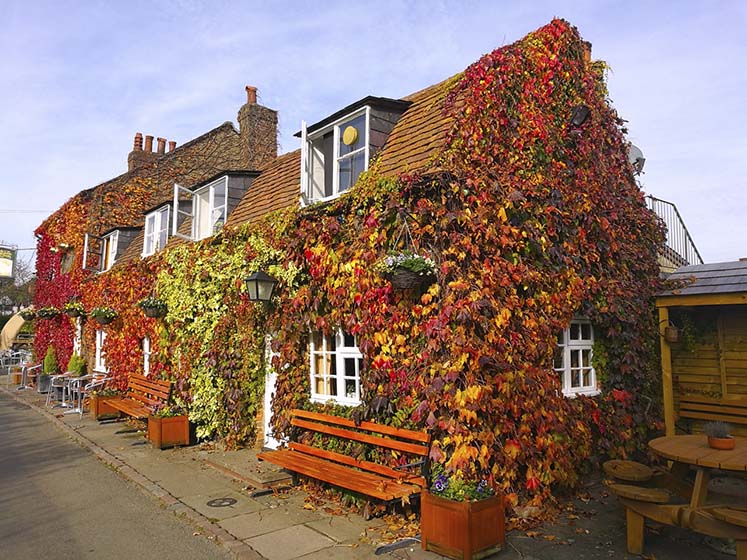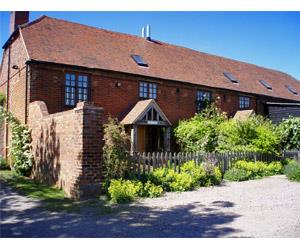The hotel is conveniently located a short drive from the historic Roman city of St Albans, close…
Around delightful Little Gaddesden

6 miles (9.7kms)
About the walk
Little Gaddesden and John O’Gaddesden
Little Gaddesden is a delightful village set mainly on the east side of a road diverted to its present course in 1286 when Ashridge Park was created by Edmund, Earl of Cornwall. Many of the present houses and cottages were built for the Brownlow Estate and have a distinctive ‘B’ on their gables. The best house is John O’Gaddesden’s House, at the junction with Church Road. It was reputedly built for John, a physician to King Edward III who retired here. Sadly it dates from about 1500, long after he was dead. However it is a mysterious building and was not originally a house and is of very high quality timber-framing. Whatever its original purpose it was enlarged in the 17th century and converted into a very attractive house. Some framing is exposed, particularly on the left range which is the oldest part. The long range attached is the 17th-century part and is also timber-framed, although the projecting or jettied upper floor’s timbers are hidden under a colourwashed render. The steep-tiled roofs are topped by fine tall brick stacks.
St Peter and St Paul Church is situated in splendid isolation well away from the village. Its churchyard is fringed with pines, oaks and firs, while shaped yew bushes decorate the churchyard itself. The church has battlemented parapets and the oldest parts are 15th century. The major interest is inside. Here you will find a superb collection of monuments, many in the rib-vaulted southeast chapel of about 1830, to the Earls and Dukes of Bridgewater and their family, ranging from the 17th to the 19th centuries.
Nettleden: A Chiltern secret
Nettleden, a parish only since 1895 and a chapelry of Pitstone in Buckinghamshire until then, has a church largely rebuilt in brick in 1811 for the Earl of Bridgewater of Ashridge utilising some remnants of its medieval predecessor. The village has a couple of medieval and 17th-century timber-framed cottages and later brick ones, notably Church House in early 18th-century brick and Yew Tree Cottage. In the bottom of the valley Nettleden is a delightful backwater with its yew-tree filled churchyard.
Walk directions
From the car park head south with open common to your left. Beyond Meadow House Farm the lane becomes a hedged track between cultivated fields, then tarmac again approaching St Margaret’s Farm. Beyond you see the roof of the temple of the Amaravati Buddhist Monastery, founded here high in the Chilterns in 1985.
At the monastery name board turn right on to the footpath to Nettleden, initially along a gravelled drive beside Beech Tree Cottage, then a shady path. Soon you walk alongside a hedge with fields to your right and descend between cultivated field to your right and paddocks to your left. At the road turn left into the small but very attractive village of Nettleden to visit St Lawrence's Church.
Retrace your steps along the lane and, just before the village sign, bear half right into a very long arable field but with the path route clear, all the while following the floor of a dry valley as it gently ascends northwestwards. Eventually the path climbs out to a kissing gate. Go through this, then go half left across a pony paddock and through another kissing gate to the road.
Cross the road into Cromer Close, then between gardens, shortly turning right, still between garden hedges to a recreation ground. Cross this to enter the woodland of the Ashridge Estate. Over a track, head for a waymarker post, then descend to a curving track. Follow this downhill and, where the wood ends at grassland, go immediately right at another waymarker post back uphill into the woods. At a metal fence bear right between low flint walls to reach the road.
Cross the road to the pavement and bear left along the lane to walk through Little Gaddesden village. Beyond Hudnall Road is the long, narrow village green, houses and cottages on its right. The tall cross is a memorial to Adelaide, Countess Brownlow, erected in 1917, and gives a wonderful view through to her house, Ashridge.
Just before Church Road and behind the war memorial is the partly medieval building known as John O’Gaddesden’s House. Turn right into Church Road and pass the school and sports fields. At a kissing gate opposite Field House go half right across a paddock to another kissing gate. Next go left alongside a row of trees to another kissing gate. Cross towards Little Gaddesden church and through another kissing gate to cross the road into the churchyard.
Leave the churchyard through the gate and bear left to a kissing gate. Go through this, cross a paddock and through another kissing gate and continue alongside a hedge. Another kissing gate takes you into a paddock, and through another kissing gate continue between gardens to a road. Here, continue ahead to the crossroads in Hudnall. Continue ahead back to the car park.
Additional information
Tracks, quiet lanes, field paths, no stiles
Chalk ridge, woodland and valley
On lead near deer and paddocks
OS Explorer 181 Chiltern Hills North
Car park on west edge of Hundall Common (NT Ashridge Estate)
None on route
WALKING IN SAFETY
Read our tips to look after yourself and the environment when following this walk.
Find out more
Also in the area
About the area
Discover Hertfordshire
As Hertfordshire is so close to London, many of its towns have become commuter havens. St Albans, less than 19 miles (30km) from the capital, has retained its distinctive character, along with many historic remains. The Roman city of Verulamium is situated in a nearby park, and excavations have revealed an amphitheatre, a temple, parts of the city walls and some house foundations. There are also some amazing mosaic pavements.
The abbey church at St Albans is thought to have been built on the same site where St Alban met his martyrdom in the 3rd century. The abbey was founded in 793 by King Offa of Mercia, and contains the saint’s shrine, made of Purbeck marble. Lost for years, it was discovered in the 19th century, in pieces, and restored by the designer of the red telephone box, Sir Giles Gilbert Scott. The abbey also contains some wonderful medieval wall paintings. Nicholas Breakspear was born in St Albans, the son of an abbey tenant. In 1154 he took the name Adrian IV, and became the first, and so far only, English pope. Another famous son of Hertfordshire was Sir Francis Bacon, Elizabethan scholar and Lord High Chancellor, born in Hemel Hempstead in 1561.
Nearby stays
Restaurants and Pubs
Nearby experiences
Recommended things to do
Why choose Rated Trips?
Your trusted guide to rated places across the UK
The best coverage
Discover more than 15,000 professionally rated places to stay, eat and visit from across the UK and Ireland.
Quality assured
Choose a place to stay safe in the knowledge that it has been expertly assessed by trained assessors.
Plan your next trip
Search by location or the type of place you're visiting to find your next ideal holiday experience.
Travel inspiration
Read our articles, city guides and recommended things to do for inspiration. We're here to help you explore the UK.













